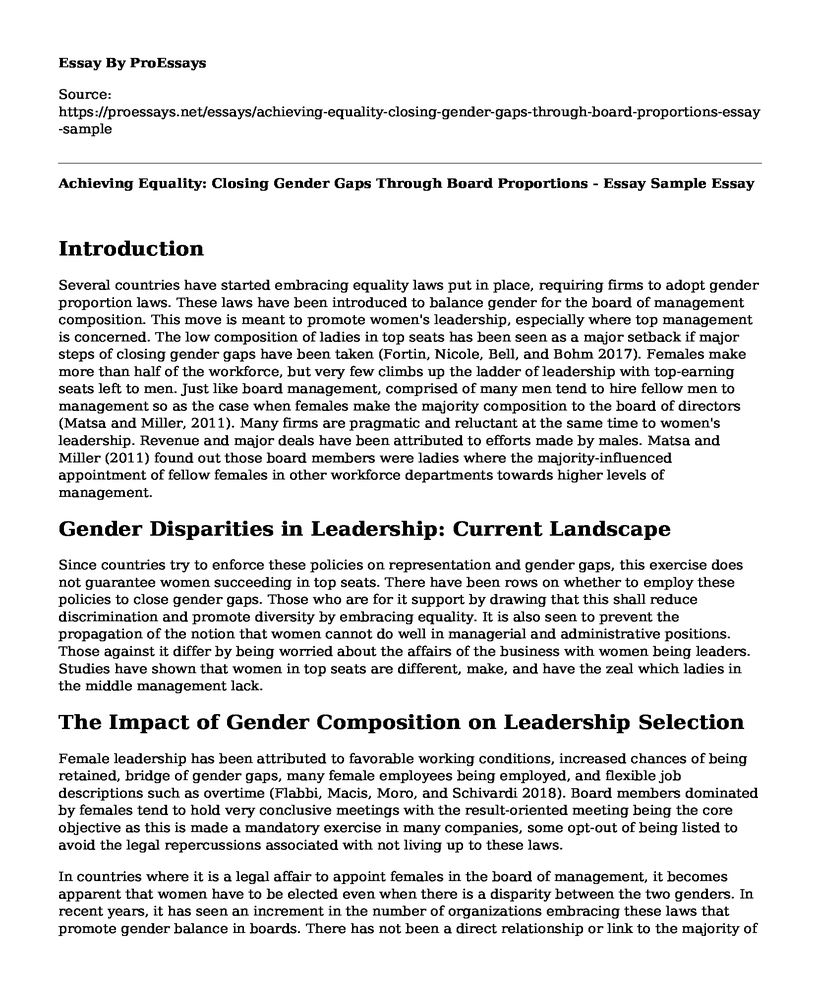Introduction
Several countries have started embracing equality laws put in place, requiring firms to adopt gender proportion laws. These laws have been introduced to balance gender for the board of management composition. This move is meant to promote women's leadership, especially where top management is concerned. The low composition of ladies in top seats has been seen as a major setback if major steps of closing gender gaps have been taken (Fortin, Nicole, Bell, and Bohm 2017). Females make more than half of the workforce, but very few climbs up the ladder of leadership with top-earning seats left to men. Just like board management, comprised of many men tend to hire fellow men to management so as the case when females make the majority composition to the board of directors (Matsa and Miller, 2011). Many firms are pragmatic and reluctant at the same time to women's leadership. Revenue and major deals have been attributed to efforts made by males. Matsa and Miller (2011) found out those board members were ladies where the majority-influenced appointment of fellow females in other workforce departments towards higher levels of management.
Gender Disparities in Leadership: Current Landscape
Since countries try to enforce these policies on representation and gender gaps, this exercise does not guarantee women succeeding in top seats. There have been rows on whether to employ these policies to close gender gaps. Those who are for it support by drawing that this shall reduce discrimination and promote diversity by embracing equality. It is also seen to prevent the propagation of the notion that women cannot do well in managerial and administrative positions. Those against it differ by being worried about the affairs of the business with women being leaders. Studies have shown that women in top seats are different, make, and have the zeal which ladies in the middle management lack.
The Impact of Gender Composition on Leadership Selection
Female leadership has been attributed to favorable working conditions, increased chances of being retained, bridge of gender gaps, many female employees being employed, and flexible job descriptions such as overtime (Flabbi, Macis, Moro, and Schivardi 2018). Board members dominated by females tend to hold very conclusive meetings with the result-oriented meeting being the core objective as this is made a mandatory exercise in many companies, some opt-out of being listed to avoid the legal repercussions associated with not living up to these laws.
In countries where it is a legal affair to appoint females in the board of management, it becomes apparent that women have to be elected even when there is a disparity between the two genders. In recent years, it has seen an increment in the number of organizations embracing these laws that promote gender balance in boards. There has not been a direct relationship or link to the majority of females in boards to the appointment of more women in top seats, not until after some years lapse. Even when a woman is made the CEO of a firm, it does not translate to many women being appointed to top-earning positions. Males still dominate.
Conclusion
Where culture plays a major role in countries, and consequently, in organizations, gender gaps may take some time. Some women see it as an opportunity to exploit the fear of being looked upon by their subordinates. Since more women might be voted in board members' composition, they are not voted in a superior position to be able to bring about change in their organizations on issues about hiring and recruitment of fellow females (Maida & Weber, 2020). While such actions on gender gaps, closing is a major development towards equality still, it is not the best method to bring more women into action.
References
Flabbi, L., Macis, M., Moro, A. and Schivardi, F. (2018) Do female executives make a difference? The impact of female leadership on gender gaps and firm performance, Working Paper.
Fortin, Nicole M., Brian Bell, and Michael Bohm (2017) "Top earnings inequality and the gender pay gap: Canada, Sweden, and the United Kingdom," Labour Economics, vol. 47, issue C, 107-123.
Maida, A., & Weber, A. (2020). Female Leadership and Gender Gap within Firms: Evidence from an Italian Board Reform. Retrieved 27 February 2020, from https://papers.ssrn.com/sol3/papers.cfm?abstract_id=3390087
Matsa, David A., and Amalia R. Miller (2011) Chipping Away at the Glass Ceiling: Gender Spillovers in Corporate Leadership. American Economic Review, 101, 635-639.
Cite this page
Achieving Equality: Closing Gender Gaps Through Board Proportions - Essay Sample. (2023, Apr 10). Retrieved from https://proessays.net/essays/achieving-equality-closing-gender-gaps-through-board-proportions-essay-sample
If you are the original author of this essay and no longer wish to have it published on the ProEssays website, please click below to request its removal:
- The Roots of Gender Inequality in Developing Countries Essay
- Effects of Overpopulation on the Environment Essay
- Fake News Discussion
- Al-Qaeda in the Islamic Maghreb (AQIM) Paper Example
- Alcohol, Sexual Assault & College Women: Research Paper
- Essay Sample on Model Minority Myth: Discriminatory & Demographically Antagonizing Concept
- Amphetamines: Stimulants, Street Names, and Forms - Essay Sample







